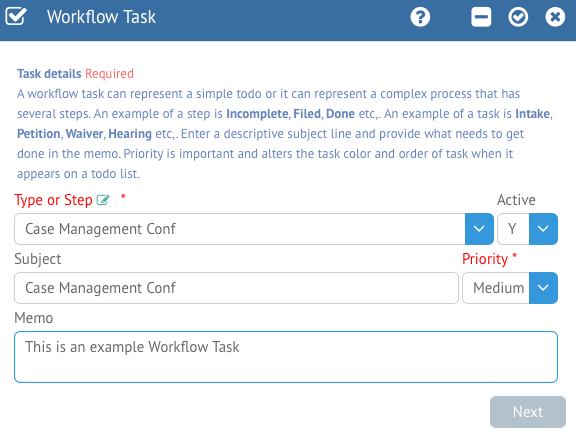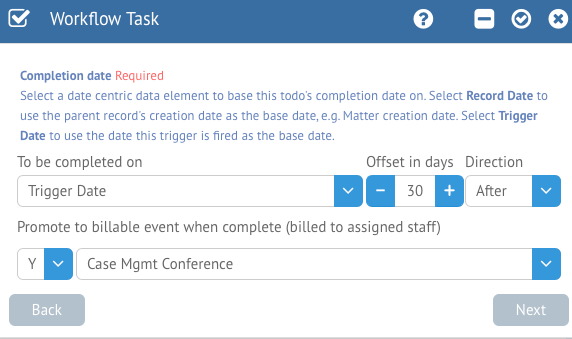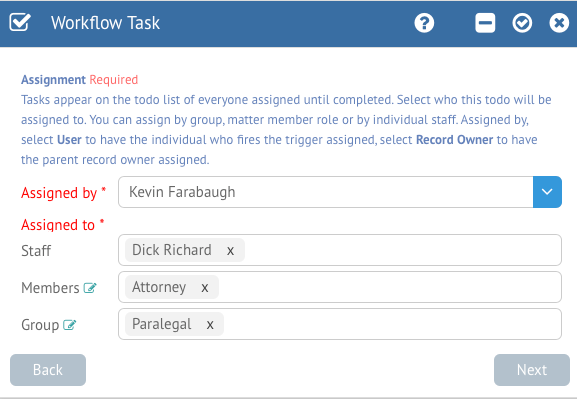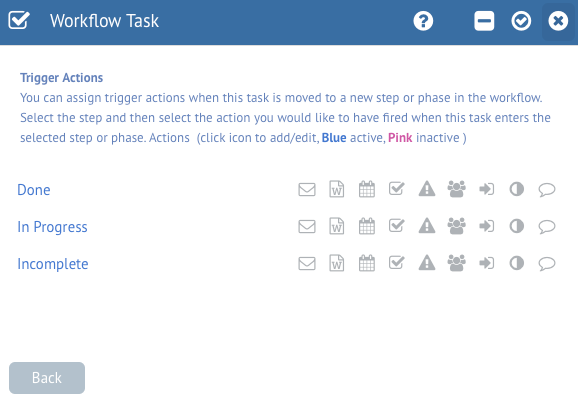Workflows in HoudiniEsq 2.0 are a sequence of steps through which tasks pass from initiation to completion. Tasks can be assigned to one or more Staff, and the progress of each Task can be tracked in real time for any Matter which they are assigned. Workflows allow you to use a Kanban-style chart to display your key tasks for each case in a more natural manner, and each “step” in a Workflow allows you to assign Triggers that occur when the task is moved to it on the chart. You can create workflows in Customize Mode.
Before We Begin
When thinking about Workflow breakdown you should consider that there are two critical elements in HoudiniEsq. These are Type and Subtype. Every record must have a Type. Every Type can have as many as 256 subtypes, as well ash Status Codes. These type-subtype-status combinations are used to show hide additional fields, execute triggers that generate items such as a document draft or calendar an event.
Note that while Workflows use Todo records for their task assignments, unlike traditional Todo records (which are only viewable by Staff who are directly involved in the Todo) Workflows can be viewed by anyone who is a Matter Member. This allows any involved Staff to see the current progress of the Workflow assignment.
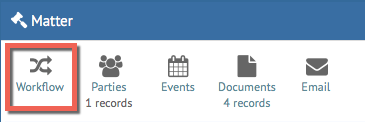
Workflow Designer
To access Workflow for a specific Matter, click on the Workflow icon in the Matter record. If the Matter does not have a currently defined Workflow, the Workflow Designer should automatically appear. If there is already a defined workflow you may have to click the gear icon button to open the designer. The Workflow Designer is ONLY available to Administrative users.
The Workflow Designer will allow you to add Tasks for your users to complete, as well as Steps for each task.
First, click the Steps selection field at the left of the screen. Select your steps in sequential order. You can also add a new Step by typing the name of the step, and pressing the Enter key to add it to the list of available Steps.
The current Steps for the added Workflow will be shown in the chart. To add Tasks to the workflow to be performed, click the “Add Task” button in the Designer.
You will then be able to update the Type (or Step) of the Task, Subject, Priority and Memo. The Type can be defined from a list of current Todo types, or you can simply add a new Type by entering the value you’d like and pressing enter. You can temporarily deactivate this Task in the Workflow process without removing it entirely by switching Active from Y to N as well. Once finished, click Next to move on to the next Screen.
Next, you can determine the due date of this Task by selecting the Base Date, Offset and Direction in the first line. The Base Date can be a Trigger Date (i.e. when you create the Workflow) the Record Creation Date (in this case, the Matter’s original creation date), or a Key Date from the Matter. Setting it to a Key Date is the most flexible option, as you can freely change that date before creating the workflow. Offset will allow you to set a value in days, and Direction lets you determine Before or After. For example, if you have a Statute of Limitations, you’ll want the offset to be your number of days and the Direction to be After. For tasks leading up to a Court Date, usually you’ll use the Before option.
You can also optionally promote the task to a Billable event once it reaches the final step. Switching the toggle box to “Y” will indicate you wish to do so, and additionally you can define an Event Type for the created Event.
Next, we will determine who is assigned to this task. Much like the Todo trigger action, you can determine who this Todo will be assigned by, and can then assign to specific Staff members, Matter Members by role (such as Attorney or Assistant), or Group (such as Paralegal or Admin). Multiple Staff, Members or Groups can be selected. Click Next to proceed.
Finally, you will be able to create Trigger Actions for each of the steps defined on this Task. When the Task is moved to that Step by a user, the actions specified here will occur. For more information on how to set up Trigger Actions, refer to the Trigger Actions Overview page. Keep in mind that the actions specified will only fire once per Workflow per Staff, so unless the Workflow is deleted and recreated, they will not occur more than the first time the Task is moved to that step by a Staff member.
Using Workflows
To create a new Workflow, click the Generate Workflow button.
Each assigned user will have a task to do. As they complete that task, they can drag it to the next step in the sequence. Once the task reaches the final step, it will be considered finished, and the task marked as Complete. Each Step can trigger the creation of multiple other records or notices as well as defined in Customize Mode.



